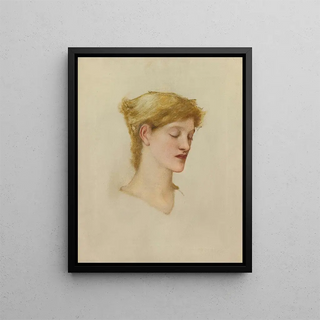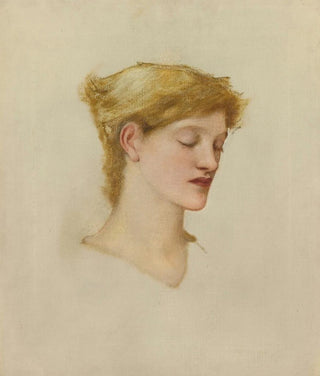Art print | Woman's head - Sir Edward Coley Burne-Jones


View from behind

Frame (optional)
Sir Edward Coley Burne-Jones's "Head of a Woman" is a piece that embodies the very essence of the Pre-Raphaelite movement, revealing timeless beauty and striking emotional depth. This work, both delicate and powerful, captures the eye and invites introspective contemplation. The artist, renowned for his ability to capture the feminine soul, offers us here a portrait that goes beyond mere representation. It is an exploration of feelings and aspirations, a reflection of an era where art intertwined with poetry and mythology. Immersing oneself in this piece transports the viewer to a universe where beauty and melancholy coexist harmoniously.
Style and uniqueness of the work
Burne-Jones's style is distinguished by meticulous attention to detail and masterful use of colors. In "Head of a Woman," delicate shades of skin contrast with rich, textured backgrounds, creating an atmosphere that is both dreamlike and tangible. The artist skillfully plays with light and shadow, emphasizing the features of his muse, who appears both fragile and resilient. The composition evokes a sense of serenity, almost mystical, while the woman's eyes, filled with depth, seem to tell stories of passions and unfulfilled desires. Every element of this work is carefully orchestrated, demonstrating technical mastery that transcends simple portraiture to become a true ode to femininity.
The artist and his influence
Sir Edward Coley Burne-Jones, an emblematic figure of the Pre-Raphaelite movement, left his mark on his era through an innovative artistic approach. Influenced by Renaissance ideals and Romantic literature, he reinvented portraiture by infusing it with a narrative and symbolic dimension. His work, of which "Head of a Woman" is a perfect example, explores themes of love, beauty, and destiny, drawing from a rich mythological repertoire. Burne-Jones also cultivated connections with other artists of his time, such as Dante Gabriel Rossetti and William Morris, contributing to an artistic dialogue that

Matte finish

View from behind

Frame (optional)
Sir Edward Coley Burne-Jones's "Head of a Woman" is a piece that embodies the very essence of the Pre-Raphaelite movement, revealing timeless beauty and striking emotional depth. This work, both delicate and powerful, captures the eye and invites introspective contemplation. The artist, renowned for his ability to capture the feminine soul, offers us here a portrait that goes beyond mere representation. It is an exploration of feelings and aspirations, a reflection of an era where art intertwined with poetry and mythology. Immersing oneself in this piece transports the viewer to a universe where beauty and melancholy coexist harmoniously.
Style and uniqueness of the work
Burne-Jones's style is distinguished by meticulous attention to detail and masterful use of colors. In "Head of a Woman," delicate shades of skin contrast with rich, textured backgrounds, creating an atmosphere that is both dreamlike and tangible. The artist skillfully plays with light and shadow, emphasizing the features of his muse, who appears both fragile and resilient. The composition evokes a sense of serenity, almost mystical, while the woman's eyes, filled with depth, seem to tell stories of passions and unfulfilled desires. Every element of this work is carefully orchestrated, demonstrating technical mastery that transcends simple portraiture to become a true ode to femininity.
The artist and his influence
Sir Edward Coley Burne-Jones, an emblematic figure of the Pre-Raphaelite movement, left his mark on his era through an innovative artistic approach. Influenced by Renaissance ideals and Romantic literature, he reinvented portraiture by infusing it with a narrative and symbolic dimension. His work, of which "Head of a Woman" is a perfect example, explores themes of love, beauty, and destiny, drawing from a rich mythological repertoire. Burne-Jones also cultivated connections with other artists of his time, such as Dante Gabriel Rossetti and William Morris, contributing to an artistic dialogue that






